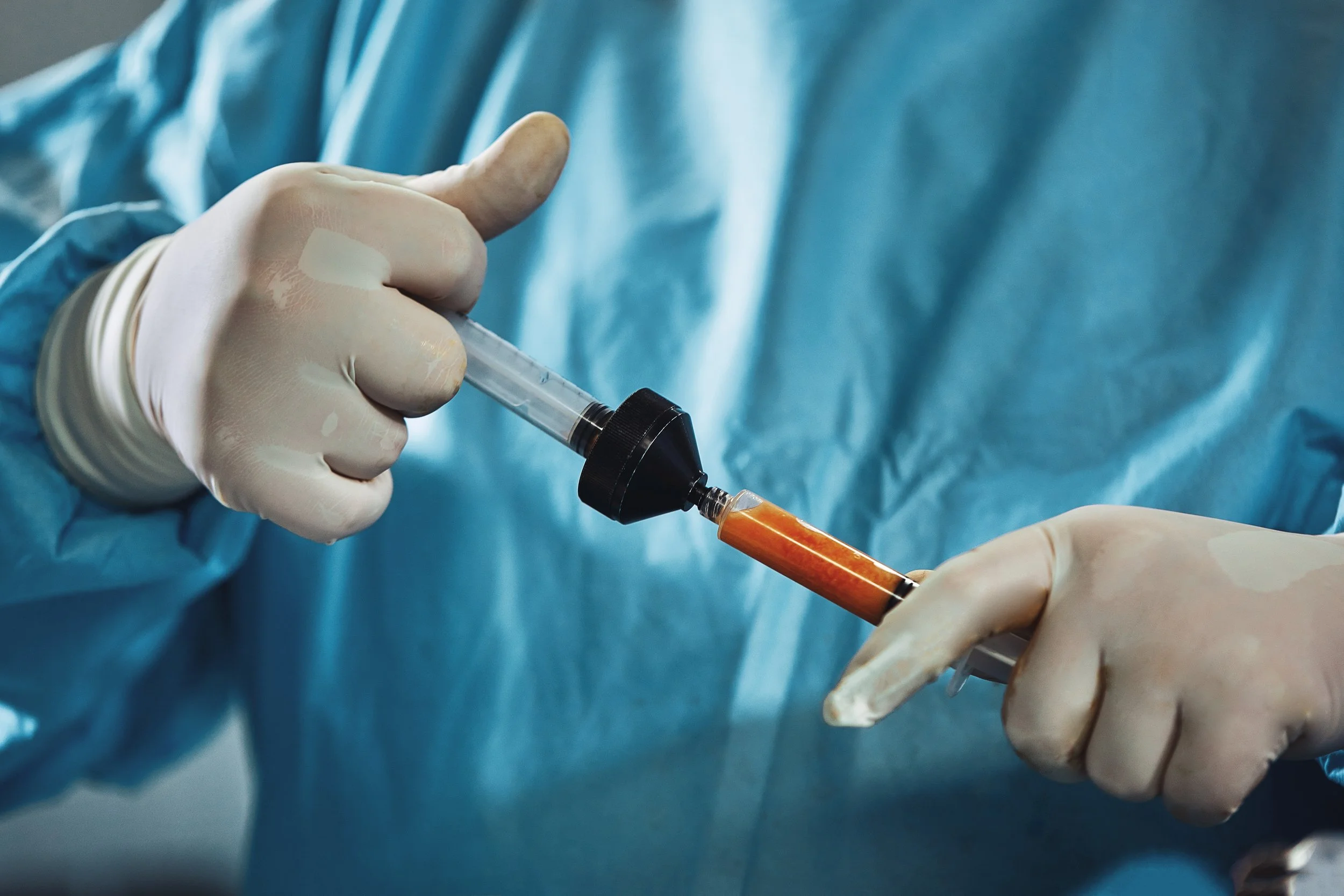
Fat Transfer
What is Fat Transfer?
A fat transfer (sometimes referred to as fat grafting) is a cosmetic surgery that uses liposuction to remove fat from undesirable areas while transferring fat to another area to enhance its size or improve its shape. By enhancing one area with injected fat while slimming down and reshaping nearby areas with liposuction, patients can achieve dramatic changes to their body. At Valespring Cosmetic Surgery Institute, Dr. Stephanie Dreckmann will develop a surgical plan unique to your needs and will help you achieve your vision for your body. Dr. Dreckmann is a board-certified, highly talented plastic surgeon who specializes in body contouring, with years of expertise performing fat transfers in the Greater Toronto Area.
Why Get a Fat Transfer?
Boost self-confidence and self-esteem
Natural look and feel
Simultaneously remove fat from unwanted areas while transferring it to more desirable areas
No major skin scars associated with liposuction and fat injection
Achieve a more contoured figure, improve your body’s proportions and get a fuller butt or breasts
Fill in areas around prominent bones, tendons and veins on the back of the hands to reduce an aged look
Obtain a more permanent solution than fillers for facial volumization
Males: Create a more muscular and toned appearance with fat transfer to the chest or shoulders
Am I Candidate for Fat Transfer?
Valespring Cosmetic Surgery Institute follows all guidelines from the College of Physicians and Surgeons of Ontario to maximize patient safety, and Dr. Dreckmann will personally perform any necessary physical assessments during a consultation to evaluate your eligibility as a surgical candidate. The following are a general set of requirements to be an eligible candidate for fat transfer surgery:
Generally fit and healthy
Body mass index (BMI) less than 35
You can calculate your BMI here
Smokers should quit smoking at least 4 weeks prior to surgery, as well as after
You are maintaining a stable weight
The transferred fat is just as susceptible to changing size when weight is gained or lost
Realistic expectations
With a consultation at Valespring Cosmetic Surgery Institute, Dr. Dreckmann will help provide realistic expectations by aligning your desired outcome with your age, lifestyle, physique and proportions so that you have a clear idea of what you can expect in your final result.
Valespring reserves the right to turn down patients who do not meet the necessary physical or psychological criteria for cosmetic surgery, and would do so only because we make your health and safety our top priority.
Common Areas For Fat Transfer
Fat Transfer to Breast
No implants are required for a fat transfer to the breasts and it is perceived as a more natural breast enhancement method, especially in look and feel. The procedure is minimally invasive and also has less dramatic results than breast implants. Breast size is typically increased by 1/2 to 1 cup.
Fat Transfer to Butt and/or Hips
A fat transfer to the buttocks is typically referred to as a Brazilian Butt Lift, or BBL. In addition to enhancing the buttocks’ size and shape, the liposuction in a BBL surgery targets specific areas around the flanks, lower back, and abdomen to contour the body in a way that accentuates a natural looking hourglass figure with a prominent butt.
Fat Transfer to Hands
A fat transfer to the hands seeks to fill in the “deflated” look of aged hands, reducing the prominence of bones and veins. Around 25 cc of fat is harvested, per hand, using liposuction and then injected into the back of the hands, and massaged to create a smoother look.
Fat Transfer to the Face
A fat transfer can be performed to select areas of the face to achieve volumization and a more youthful appearance. Some patients who have done fillers to the area for a prolonged period prefer this option as a more permanent solution.
Fat Transfer for Men
Sometimes despite proper diet and exercise, it can be challenging to achieve a well-defined and muscular look. Fat transfer can be performed to select areas, most commonly the chest and shoulders, in order to create a more sculpted appearance.
Liposuction + Body Contouring
Fat Removal for Transfer
In order to transfer fat, the patient will need to have liposuction performed to harvest the fat first. Some fat transfer procedures, like a Brazilian Butt Lift (fat transfer to the buttocks), require liposuction in targeted, neighbouring areas to contour the body and make a certain area appear more prominent. Other fat transfer procedures may harvest the fat from any number of locations of the patient’s choosing.

Let us guide you through the decision
Book a Free Fat Transfer Consultation Now!
How Much Does a Fat Transfer Cost?
Fat Transfer to Breast
$10000+
(or $3000+ as an add-on for select liposuction procedures)
Cost Includes:
Liposuction for the purposes of fat harvest*
Fat transfer to both breasts
Surgical bra
Fat Transfer to Hips and/or Butt
$14000 - $16000+
Cost Includes:
Liposuction of at least one area
The base cost for a fat transfer to hips and buttocks fluctuates in the given range depending on the number of key areas identified for liposuction. These areas are identified by your surgeon to achieve your body’s ideal contour.
Fat transfer to hips and/or buttocks
Compression garment
Fat Transfer to other areas
(Face, Chest, etc.)
$8000+
Prices vary considerably. It is best to book a FREE consultation with Dr. Stephanie Dreckmann to develop a custom surgical plan tailored to you. If you are a surgical candidate, you will be provided with a written quote following your consultation.
Fat Transfer to Hands
$9000+
(or $2000+ as an add-on for select liposuction procedures)
Cost Includes:
Liposuction for the purposes of fat harvest*
Fat transfer to both hands
Additional Liposuction
$1000 - $4500+ per area
Cost Includes:
Liposuction of an additional area when added to a qualifying fat transfer procedure
Optional Overnight Stay
$4000
Patients normally return home on the same day of the procedure, but some would like the extra peace of mind of staying in an overnight bed in our medical facility, under the supervision of 2 personal attendants.
Cost Includes:
Overnight stay in one of our beds
Nurse supervision for the length of your stay
Meals for dinner and breakfast the following morning
Consultations are free with no obligation
If you have any questions about our pricing or have specific needs, do not hesitate to contact us
*Liposuction for the purposes of fat harvest includes liposuction in a mutually agreed upon area for fat harvest, but includes only the amount required for fat transfer (does not include liposuction of the entire area)
Prices serve as a guideline only. Fees will be adjusted based on each patient’s individual anatomy and the complexity of the case.
Prices do not include HST

Get your fat transfer now, make payments later!
FAQs about Fat Transfer
-
All fat transfer procedures will have some of the transferred fat die within the first few days, and some of the fat will be absorbed by the body. This is both expected and safe. Approximately 50 to 80 percent of the transferred fat cells can be expected to survive. It is extremely important to adhere to your surgeon’s post-op instructions to maximize the number of fat cells retained after the transfer.
About 6-12 months after fat transfer, the remaining fat cells should be established and the results of your fat transfer should be permanent. It should be noted that the number of fat cells in your body does not vary over time, and when you gain or lose weight, your fat cells increase or decrease in size. This implies that gaining body weight may correspond to an increase in size in the area fat was transferred to, and losing body weight may correspond to a decrease in size in the area fat was transferred to. For this reason, it’s advised to have achieved a healthy and stable target weight before pursuing fat transfer.
-
It depends on what area of the body you are treating and the desired outcome.
For a fat transfer breast augmentation, typically around 200 to 300 cc of fat to increase up to one cup size. This is the limit on how much fat can be transferred in a single procedure while having a sufficient amount of the fat cells survive. An average fat transfer breast augmentation increases the breast size between 1/2 cup to 1 cup. If you wish to increase your breast size naturally beyond 1 cup, you may require multiple fat transfer procedures, otherwise you may have to consider breast implants.
For a fat transfer to butt and hips (also known as a Brazilian Butt Lift or BBL), the average patient requires about 1000 cc or 1 L of fat for transfer.
For a fat transfer to hands, about 20 to 25 cc are required per hand.
-
Fat grafting is another name for fat transfer surgery, or fat relocation. The procedure involves removing fat from one area of the body with liposuction and then injecting that fat into another area. The fat removal allows for body contouring in one area, and the fat injection allows for an augmentation in another area.
-
All types of surgeries have risks, including a fat transfer, but fat transfer surgery is generally regarded as a safe procedure. Any risks or concerns will be outlined during the consultation. The procedure will be performed by our experienced, board-certified plastic surgeon, Dr. Dreckmann, in our on-site accredited surgical facility to optimize patient safety.
-
The post-operative protocol for fat transfers varies from procedure to procedure. The healing time also varies.
After surgery, it is critical that the recommended post-operative instructions are followed as the long term results of the surgery are greatly influenced by aftercare post-surgery.
It often takes 3-12 months to appreciate the final result after a fat transfer procedure.
Patients are usually capable of returning to work within 1 to 2 weeks. Depending on where the fat is transferred, you may have to avoid direct pressure on that area for up to 6 weeks. A compression garment must be worn for 4 to 6 weeks after surgery to ensure best fat transfer results.
-
Liposuction can be done twice in the same area, but it is up to the discretion of your plastic surgeon to see if you are eligible and that you stand to benefit from a second liposuction surgery in that area. Your surgeon may also suggest technology-assisted advanced liposuction techniques, such as ultrasound-assisted liposuction, to help break down previously formed scar tissue.
-
During the fat transfer surgery, you will typically be put to sleep under general anesthesia so that you feel nothing during the procedure.
For the first few days, you will likely experience moderate pain and tenderness. Your surgeon will have provided you with medication to help control the pain.
During the first and second week, the pain should have largely subsided, and most people are capable of returning to work after two weeks, assuming it is not physically strenuous.










